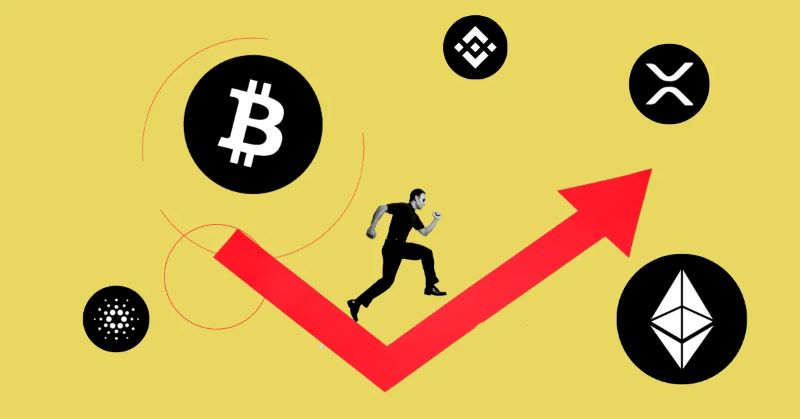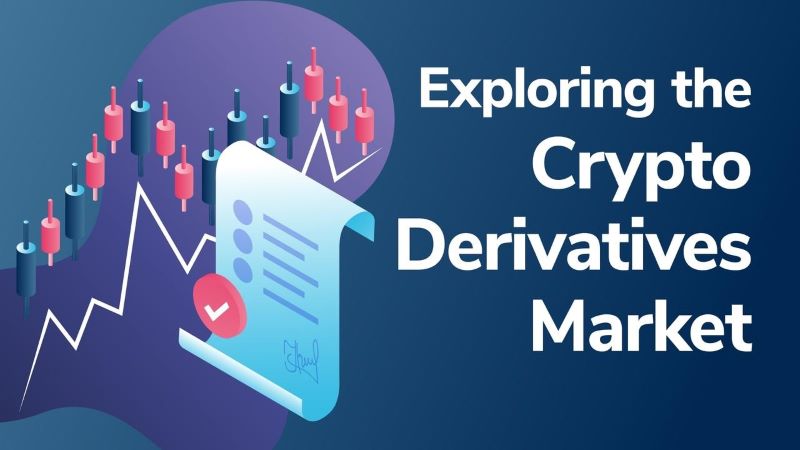With buzz about Bitcoin and Ethereum, you’ve likely heard traders talk about What are Crypto Derivatives. But what are they? Think of crypto derivatives like a bet on a crypto’s future price. They’re complex yet hold big sway in market moves. If you want to trade smarter, not harder, grasp how these tools work and why they matter. Get ready to dive into the world of crypto derivatives and unlock their potential to change your digital trading game. In this guide, we’ll clear up the fog around these digital trading instruments and show you how to use them to your advantage.
What Are Crypto Derivatives?
Crypto derivatives are like tools in a toolbox for the digital money world. They are contracts based on the future price of cryptocurrencies. Unlike buying Bitcoin or Ethereum directly, you don’t own the coin. Instead, you hold a contract that bets on price changes. Just as you’d use a saw to cut wood, you’d use crypto derivatives to make money from price moves.
The Role of Crypto Derivatives in Market Dynamics
Crypto derivatives are essential in shaping price movements in the cryptocurrency market. They enhance price stability and allow traders to hedge against volatility. When traders anticipate rising prices, they can leverage derivatives to capitalize on potential profits, while those expecting declines can mitigate risks.
These instruments, including futures, options, and swaps, provide various trading strategies and leverage opportunities. Leverage allows traders to control larger positions with less capital, increasing both potential gains and losses. Thus, understanding their mechanics is crucial to avoid unexpected pitfalls.
Additionally, crypto derivatives can attract more participants to the market, leading to increased liquidity and stability. However, they also come with risks, such as price fluctuations and counterparty issues. Continuous improvements in regulation and transparency are necessary to enhance safety.
Ultimately, crypto derivatives offer powerful tools for risk management and portfolio diversification. As the crypto landscape evolves, staying informed about new products and strategies is vital for effective investment in this dynamic space.
Types of Cryptocurrency Derivatives and Their Mechanics
Cryptocurrency derivatives are financial instruments that derive their value from the price of underlying cryptocurrencies. They offer various benefits, including hedging, speculation, and enhanced trading strategies. Here’s a look at the main types of cryptocurrency derivatives and their mechanics:
Futures Contracts
Futures contracts obligate traders to buy or sell a specific cryptocurrency at a predetermined price on a set date in the future. They allow traders to speculate on price movements or hedge against potential losses. For example, if a trader expects Bitcoin to rise, they can lock in a purchase price today, potentially profiting when the contract matures.
Options Contracts
Options contracts provide the buyer with the right, but not the obligation, to buy (call option) or sell (put option) a cryptocurrency at a specified price before a certain expiration date. This flexibility allows traders to manage risk or speculate without the commitment to transact. Strategies can vary widely depending on market conditions and trader objectives.
Swaps
Swaps are agreements between two parties to exchange cash flows or returns based on the performance of an underlying cryptocurrency. For example, one party might exchange fixed payments for returns tied to a cryptocurrency’s price, allowing them to hedge against price fluctuations while gaining market exposure.
Perpetual Contracts
Perpetual contracts function similarly to futures contracts but do not have an expiration date. Traders can hold these positions indefinitely, making them popular for ongoing speculation. They often involve funding fees to ensure the contract price aligns closely with the underlying asset’s price.
Exchange-Traded Products (ETPs)
ETPs, such as Exchange-Traded Funds (ETFs) and Exchange-Traded Notes (ETNs), track the performance of specific cryptocurrencies or baskets of cryptocurrencies. They provide a way for investors to gain exposure to the crypto market without directly owning the underlying assets, making them accessible to traditional investors.
Trading Cryptocurrency Derivatives Thoughtfully
When diving into crypto derivatives, think of it as navigating a high-stakes game. To succeed, you need solid strategies and a good understanding of leverage. Leverage allows you to trade with less money while controlling larger amounts. Imagine it as using a small key to unlock a treasure chest.
However, using leverage can be tricky. Picture pushing a shopping cart with one arm—that’s trading without leverage. Now, imagine using both arms; that’s the added power of leverage. You can move more, but if you hit a bump, you risk losing a lot. Use leverage wisely—consider it a helpful tool, not a toy.
In the crypto world, you have several trading options:
- Futures Contracts: Agreements to buy or sell a cryptocurrency at a set price in the future. Think of it as betting on where the coin’s price will go.
- Options Trading: Gives you the right (but not the obligation) to buy or sell at a specific price. It’s like holding a ticket to a concert; you can go if you want, but you don’t have to if circumstances change.
- Perpetual SwapFid=s: Contracts that can run indefinitely until you decide to close them.
Navigating the Risks
Trading crypto derivatives can feel like riding a roller coaster—exciting but risky. The market can swing dramatically, so it’s essential to have safeguards in place. Hedging is one such strategy that acts as a safety net to protect your investments from sudden price drops.
Keep in mind that high rewards often come with high risks. While leverage can amplify your gains, it can also magnify your losses. Think of inflating a balloon; the more air (or money) you add, the bigger it gets. But if it pops, you’ll face a big mess.
Understanding the complexities of derivative trading requires vigilance. You need to monitor your margins closely, much like a tightrope walker balancing high above the ground. Be aware of liquidation risks—this happens when your account balance drops too low, forcing your position to close unexpectedly.
Also, watch for counterparty risk, which is the chance that the other party in the trade might not fulfill their obligations. It’s like lending your favorite toy to a friend; you hope they return it in good condition.
Regulatory Landscape and the Future of Crypto Derivative Markets
Crypto Derivatives Regulation and Investor Protection
Kids, imagine you’re playing in a park that has rules to keep you safe. In the crypto world, these rules are called “regulations,” and they protect people who trade crypto derivatives. Crypto derivatives are special deals based on the future price of cryptocurrencies like Bitcoin. Just like you need a helmet for biking, crypto traders need rules to keep their money safe.
Right now, the people in charge of money rules, like the SEC in the United States, are working hard to make new rules for crypto trading. They want to be sure that when you grow up and maybe trade these crypto deals, you won’t lose your money unfairly. These new rules are also to make sure that the big, smart computers that run the crypto world play fair.
Thinking about playing with your friends, it’s fun until someone breaks the rules, right? In crypto trading, if someone doesn’t follow the rules, people can lose lots of money. So, the rules keep everyone honest. They make sure no one can cheat, and that if something goes wrong, there’s a way to fix it.
Predicting the Evolution: Blockchain-based Solutions and Market Impact
Now, guess what? The future of playing with crypto deals looks super exciting! Think of it like playing a video game that gets better and cooler as you play. People who know a lot about computers and money are coming up with new ways to trade using a thing called “blockchain.” This is like an online notebook that very carefully keeps track of everyone’s trades.
Blockchain helps make trading faster and keeps everyone’s deals safe. This is a big deal because it means people from all over the world can trade with each other without worrying. It’s like when you trade toy cars with your friends. You want to know you’ll get a toy car back, right? Blockchain does that for crypto trading.
These future changes in how we trade crypto deals will help everyone play the game better. Also, it means more people can join in, which is really cool. It’s like inviting everyone to your birthday party and having enough cake for everyone!
And, just like when you get older and smarter, the crypto world will keep getting smarter too. This means that trading crypto will become something many people can do, not just those who are already good with money. And if something goes wrong, blockchain can help make it right again.
One thing to remember: even though these crypto deals can help people make money, they can also be risky. It’s like when you ride a bike—you might fall, but you wear a helmet just in case. With crypto, you need to learn the rules and maybe start with small trades, just like you started with training wheels.
By making good rules and using blockchain, we’re building a safter and more exciting world for trading crypto deals. And that’s something that’s super important for everyone, today and in the future!
In this post, we explored the world of crypto derivatives, from the basics to the future. We looked into how these tools play a key role in the market and learned about different types like futures and options. Plus, we touched on smart new additions like perpetual swaps.
We dived deep into tactics for smart trading and the risks that come with leverage. It’s clear that knowing how to navigate these waters is vital for success. And lastly, we tackled the rules set by regulators and pondered what’s next for crypto derivatives.
To wrap up, crypto derivatives are complex but full of chances for traders who get it right. With care and knowledge, these instruments can advance your trading game. Always weigh the risks and stay ahead with smart moves and a clear understanding of the rules. Here’s to your success in the dynamic world of crypto derivatives!
Q&A
- What exactly are crypto derivatives?
Crypto derivatives are financial instruments that derive their value from the price movements of an underlying cryptocurrency asset, such as Bitcoin or Ethereum. They allow traders to speculate on the future price of crypto assets without actually owning the physical currency, providing opportunities for leveraging, hedging, and accessing markets with a lower capital outlay.
- How do crypto derivatives work?
Crypto derivatives work by allowing traders to enter into agreements to buy or sell a cryptocurrency at a predetermined price on a specific future date. The most common types of crypto derivatives are futures, options, and swaps. These contracts can be traded on specialized exchanges and provide a way for traders to hedge against volatility or to speculate on price movements.
- What are the most popular types of crypto derivatives?
The most popular types of crypto derivatives are:
- Futures: Contracts to buy or sell an asset at a fixed price at a future date.
- Options: Contracts that give the holder the right, but not the obligation, to buy or sell an asset at a set price within a specific time period.
- Swaps: Agreements to exchange cash flows based on the underlying cryptocurrency’s performance.
- Perpetual Contracts: A type of futures contract without an expiry date, allowing for indefinite position holding.
- Are crypto derivatives regulated?
The regulation of crypto derivatives varies greatly by country and type of derivative. In some jurisdictions, these products are strictly regulated, while in others, they may fall into a legal grey area. It is crucial for traders to ensure that they are compliant with local laws and regulations when trading crypto derivatives.
- What risks are associated with trading crypto derivatives?
Trading crypto derivatives carries a set of risks, including market risk, liquidity risk, and leverage risk. The highly volatile nature of cryptocurrencies can lead to rapid and substantial losses, especially when leverage is employed. Additionally, the relatively nascent market can suffer from liquidity issues, which may impact the ability to open or close positions at the desired price. Traders should be well-informed and cautious when engaging with these financial instruments.





RELATED POSTS
Inter Blockchain Communication: Unveiling the Future of Cryptocurrency Connectivity
What is Inter Blockchain Communication...
Blockchain Prediction Market: Navigate the Future, Bet on Outcomes
Blockchain Prediction Market: Explore Decentralized...
How is blockchain used in DeFi: Unlocking Financial Freedom
How is blockchain used in...
Starknet: A Layer-2 scaling solution for Ethereum
Starknet is rapidly gaining traction...
What are the benefits of blockchain: How It Transforms Business and Daily Life
Discover the benefits of blockchain...
What Are Crypto Derivatives? Mystery of Digital Trading Instruments
Demystifying Crypto Derivatives: Understanding Basics,...
Popular Blockchain Security Audit Companies: Unveiling Industry Watchdogs
Discover the leading blockchain security...
Emerging Consensus Mechanisms for Blockchain: The Future of Decentralized Validation
Emerging consensus mechanisms for blockchain....
How to protect your crypto private key: Unbreakable Security Tips
Learn how to protect your...
Real-world Applications Of Blockchain Technology: Beyond Bitcoin’s Buzz
Revolutionizing finance, trade, and security....
Blockchain Decoded: How Does Blockchain Work For Beginners
How does blockchain work for...
Security of Proof of Stake: Is Your Digital Investment Safe?
Enhance PoS Security! Learn about...
How does blockchain technology help organizations when sharing data
Wondering “How does blockchain technology...
Public Key vs Private Key Cryptography: Unlocking the Secrets of Digital Security
Understanding the Basics of Public...
Unlocking Tomorrow: Examples of future applications of blockchain
Examples of future applications of...
Advantages and Disadvantages of Different Consensus Mechanisms: A Blockchain Breakdown
Explore the advantages and disadvantages...